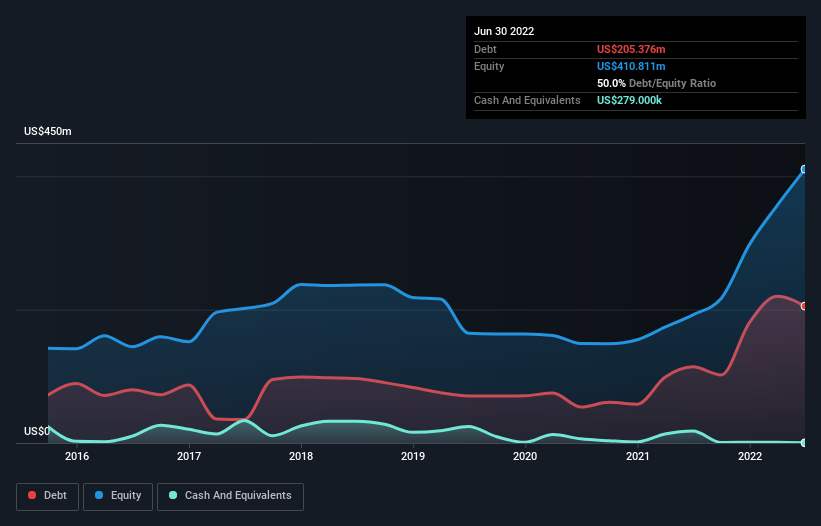- United States
- /
- Healthcare Services
- /
- NasdaqGS:CCRN
Cross Country Healthcare (NASDAQ:CCRN) Has A Pretty Healthy Balance Sheet

The external fund manager backed by Berkshire Hathaway's Charlie Munger, Li Lu, makes no bones about it when he says 'The biggest investment risk is not the volatility of prices, but whether you will suffer a permanent loss of capital.' So it seems the smart money knows that debt - which is usually involved in bankruptcies - is a very important factor, when you assess how risky a company is. We can see that Cross Country Healthcare, Inc. (NASDAQ:CCRN) does use debt in its business. But the real question is whether this debt is making the company risky.
What Risk Does Debt Bring?
Debt is a tool to help businesses grow, but if a business is incapable of paying off its lenders, then it exists at their mercy. Part and parcel of capitalism is the process of 'creative destruction' where failed businesses are mercilessly liquidated by their bankers. However, a more frequent (but still costly) occurrence is where a company must issue shares at bargain-basement prices, permanently diluting shareholders, just to shore up its balance sheet. Of course, debt can be an important tool in businesses, particularly capital heavy businesses. The first thing to do when considering how much debt a business uses is to look at its cash and debt together.
View our latest analysis for Cross Country Healthcare
What Is Cross Country Healthcare's Net Debt?
As you can see below, at the end of June 2022, Cross Country Healthcare had US$205.4m of debt, up from US$114.2m a year ago. Click the image for more detail. Net debt is about the same, since the it doesn't have much cash.

A Look At Cross Country Healthcare's Liabilities
The latest balance sheet data shows that Cross Country Healthcare had liabilities of US$268.7m due within a year, and liabilities of US$259.5m falling due after that. Offsetting this, it had US$279.0k in cash and US$707.7m in receivables that were due within 12 months. So it can boast US$179.8m more liquid assets than total liabilities.
This excess liquidity suggests that Cross Country Healthcare is taking a careful approach to debt. Because it has plenty of assets, it is unlikely to have trouble with its lenders.
We use two main ratios to inform us about debt levels relative to earnings. The first is net debt divided by earnings before interest, tax, depreciation, and amortization (EBITDA), while the second is how many times its earnings before interest and tax (EBIT) covers its interest expense (or its interest cover, for short). This way, we consider both the absolute quantum of the debt, as well as the interest rates paid on it.
Cross Country Healthcare's net debt is only 0.72 times its EBITDA. And its EBIT easily covers its interest expense, being 22.1 times the size. So we're pretty relaxed about its super-conservative use of debt. Better yet, Cross Country Healthcare grew its EBIT by 420% last year, which is an impressive improvement. That boost will make it even easier to pay down debt going forward. The balance sheet is clearly the area to focus on when you are analysing debt. But ultimately the future profitability of the business will decide if Cross Country Healthcare can strengthen its balance sheet over time. So if you're focused on the future you can check out this free report showing analyst profit forecasts.
Finally, while the tax-man may adore accounting profits, lenders only accept cold hard cash. So the logical step is to look at the proportion of that EBIT that is matched by actual free cash flow. During the last three years, Cross Country Healthcare burned a lot of cash. While that may be a result of expenditure for growth, it does make the debt far more risky.
Our View
Cross Country Healthcare's interest cover suggests it can handle its debt as easily as Cristiano Ronaldo could score a goal against an under 14's goalkeeper. But the stark truth is that we are concerned by its conversion of EBIT to free cash flow. It's also worth noting that Cross Country Healthcare is in the Healthcare industry, which is often considered to be quite defensive. Looking at the bigger picture, we think Cross Country Healthcare's use of debt seems quite reasonable and we're not concerned about it. After all, sensible leverage can boost returns on equity. When analysing debt levels, the balance sheet is the obvious place to start. But ultimately, every company can contain risks that exist outside of the balance sheet. We've identified 3 warning signs with Cross Country Healthcare , and understanding them should be part of your investment process.
Of course, if you're the type of investor who prefers buying stocks without the burden of debt, then don't hesitate to discover our exclusive list of net cash growth stocks, today.
New: AI Stock Screener & Alerts
Our new AI Stock Screener scans the market every day to uncover opportunities.
• Dividend Powerhouses (3%+ Yield)
• Undervalued Small Caps with Insider Buying
• High growth Tech and AI Companies
Or build your own from over 50 metrics.
Have feedback on this article? Concerned about the content? Get in touch with us directly. Alternatively, email editorial-team (at) simplywallst.com.
This article by Simply Wall St is general in nature. We provide commentary based on historical data and analyst forecasts only using an unbiased methodology and our articles are not intended to be financial advice. It does not constitute a recommendation to buy or sell any stock, and does not take account of your objectives, or your financial situation. We aim to bring you long-term focused analysis driven by fundamental data. Note that our analysis may not factor in the latest price-sensitive company announcements or qualitative material. Simply Wall St has no position in any stocks mentioned.
About NasdaqGS:CCRN
Cross Country Healthcare
Provides talent management services for healthcare clients in the United States.
Flawless balance sheet with moderate growth potential.
Similar Companies
Market Insights
Community Narratives



